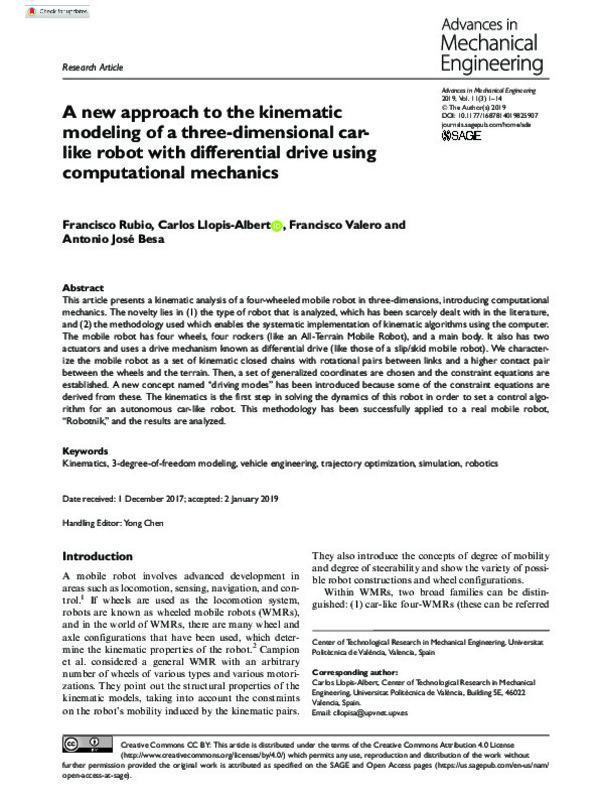JavaScript is disabled for your browser. Some features of this site may not work without it.
Buscar en RiuNet
Listar
Mi cuenta
Estadísticas
Ayuda RiuNet
Admin. UPV
A new approach to the kinematic modeling of a three-dimensional car-like robot with differential drive using computational mechanics
Mostrar el registro sencillo del ítem
Ficheros en el ítem
| dc.contributor.author | Rubio Montoya, Francisco José
|
es_ES |
| dc.contributor.author | Llopis Albert, Carlos
|
es_ES |
| dc.contributor.author | Valero Chuliá, Francisco José
|
es_ES |
| dc.contributor.author | Besa Gonzálvez, Antonio José
|
es_ES |
| dc.date.accessioned | 2020-05-26T03:03:46Z | |
| dc.date.available | 2020-05-26T03:03:46Z | |
| dc.date.issued | 2019-03-13 | es_ES |
| dc.identifier.issn | 1687-8132 | es_ES |
| dc.identifier.uri | http://hdl.handle.net/10251/144318 | |
| dc.description.abstract | [EN] This article presents a kinematic analysis of a four-wheeled mobile robot in three-dimensions, introducing computational mechanics. The novelty lies in (1) the type of robot that is analyzed, which has been scarcely dealt with in the literature, and (2) the methodology used which enables the systematic implementation of kinematic algorithms using the computer. The mobile robot has four wheels, four rockers (like an All-Terrain Mobile Robot), and a main body. It also has two actuators and uses a drive mechanism known as differential drive (like those of a slip/skid mobile robot). We characterize the mobile robot as a set of kinematic closed chains with rotational pairs between links and a higher contact pair between the wheels and the terrain. Then, a set of generalized coordinates are chosen and the constraint equations are established. A new concept named ¿driving modes¿ has been introduced because some of the constraint equations are derived from these. The kinematics is the first step in solving the dynamics of this robot in order to set a control algorithm for an autonomous car-like robot. This methodology has been successfully applied to a real mobile robot, ¿Robotnik,¿ and the results are analyzed. | es_ES |
| dc.language | Inglés | es_ES |
| dc.publisher | SAGE Publications | es_ES |
| dc.relation.ispartof | Advances in Mechanical Engineering | es_ES |
| dc.rights | Reconocimiento (by) | es_ES |
| dc.subject | Kinematics | es_ES |
| dc.subject | 3-degree-of-freedom modeling | es_ES |
| dc.subject | Vehicle Engineering | es_ES |
| dc.subject | Trajectory optimization | es_ES |
| dc.subject | Simulation | es_ES |
| dc.subject | Robotics | es_ES |
| dc.subject.classification | INGENIERIA MECANICA | es_ES |
| dc.title | A new approach to the kinematic modeling of a three-dimensional car-like robot with differential drive using computational mechanics | es_ES |
| dc.type | Artículo | es_ES |
| dc.identifier.doi | 10.1177/1687814019825907 | es_ES |
| dc.rights.accessRights | Abierto | es_ES |
| dc.contributor.affiliation | Universitat Politècnica de València. Departamento de Ingeniería Mecánica y de Materiales - Departament d'Enginyeria Mecànica i de Materials | es_ES |
| dc.description.bibliographicCitation | Rubio Montoya, FJ.; Llopis Albert, C.; Valero Chuliá, FJ.; Besa Gonzálvez, AJ. (2019). A new approach to the kinematic modeling of a three-dimensional car-like robot with differential drive using computational mechanics. Advances in Mechanical Engineering. 11(3):1-14. https://doi.org/10.1177/1687814019825907 | es_ES |
| dc.description.accrualMethod | S | es_ES |
| dc.relation.publisherversion | https://doi.org/10.1177/1687814019825907 | es_ES |
| dc.description.upvformatpinicio | 1 | es_ES |
| dc.description.upvformatpfin | 14 | es_ES |
| dc.type.version | info:eu-repo/semantics/publishedVersion | es_ES |
| dc.description.volume | 11 | es_ES |
| dc.description.issue | 3 | es_ES |
| dc.relation.pasarela | S\382059 | es_ES |
| dc.description.references | Campion, G., Bastin, G., & Dandrea-Novel, B. (1996). Structural properties and classification of kinematic and dynamic models of wheeled mobile robots. IEEE Transactions on Robotics and Automation, 12(1), 47-62. doi:10.1109/70.481750 | es_ES |
| dc.description.references | Bajracharya, M., Maimone, M. W., & Helmick, D. (2008). Autonomy for Mars Rovers: Past, Present, and Future. Computer, 41(12), 44-50. doi:10.1109/mc.2008.479 | es_ES |
| dc.description.references | Poczter, S. L., & Jankovic, L. M. (2013). The Google Car: Driving Toward A Better Future? Journal of Business Case Studies (JBCS), 10(1), 7. doi:10.19030/jbcs.v10i1.8324 | es_ES |
| dc.description.references | Wang, T., Wu, Y., Liang, J., Han, C., Chen, J., & Zhao, Q. (2015). Analysis and Experimental Kinematics of a Skid-Steering Wheeled Robot Based on a Laser Scanner Sensor. Sensors, 15(5), 9681-9702. doi:10.3390/s150509681 | es_ES |
| dc.description.references | Alexander, J. C., & Maddocks, J. H. (1989). On the Kinematics of Wheeled Mobile Robots. The International Journal of Robotics Research, 8(5), 15-27. doi:10.1177/027836498900800502 | es_ES |
| dc.description.references | Muir, P. F., & Neuman, C. P. (1987). Kinematic modeling of wheeled mobile robots. Journal of Robotic Systems, 4(2), 281-340. doi:10.1002/rob.4620040209 | es_ES |
| dc.description.references | Tarokh, M., & McDermott, G. J. (2005). Kinematics modeling and analyses of articulated rovers. IEEE Transactions on Robotics, 21(4), 539-553. doi:10.1109/tro.2005.847602 | es_ES |
| dc.description.references | Zhang, N., Zhao, Y., Wei, H., & Chen, G. (2016). Experimental study on the influence of air injection on unsteady cloud cavitating flow dynamics. Advances in Mechanical Engineering, 8(11), 168781401667667. doi:10.1177/1687814016676678 | es_ES |








